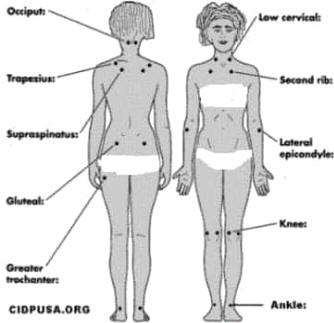FMS,
Fibromyalgia and "Perpetuating Factors

by Miryam Williamson, author of Fibromyalgia: A Comprehensive Approach (1996)
and The Fibromyalgia Relief Book (1998)
Copyright 1999 Miryam Williamson. Permission is granted to copy and distribute
this article as long as it remains intact and is not sold.
Janet Travell, MD, who died in August, 1997, was the White House physician when John F. Kennedy was president. He probably had fibromyalgia (FM), although his illness wasn't recognized as such. Dr. Travell specialized in myofascial pain syndrome (MPS) and musculoskeletal disorders. With David Simons, MD, she wrote the two-volume textbook Myofascial Pain and Dysfunction: the Trigger Point Manual.
Travell and Simons suggest that these perpetuating factors must also be identified and treated if the patient's myofascial pain syndrome is to be cured. The concept is as important in dealing with fibromyalgia as it is in treating MPS.
Insomnia. It has been shown by Moldovsky and others that anything that interferes with sleep for a few days will induce FM symptoms even in otherwise healthy people. When these people are allowed to sleep normally again, their symptoms disappear, but they are apt to linger and become permanent in people with the predisposition to fibromyalgia, which appears to run in families.
Insomnia can be a perpetuating factor in fibromyalgia, as well as a cause or trigger for the disorder. And there are conditions that are perpetuating factors for insomnia. Chief among them is obstructive sleep apnea (OSA), in which the back of the throat closes repeatedly when the individual relaxes into sleep, causing the sleeper to gasp for air. As a result, the person never achieves deep sleep. OSA is found in about half of all men with FM, and in many women, too. This condition is usually rather easy to deal with and people whose insomnia is caused by OSA usually find dramatic improvement in their FM symptoms when the OSA is successfully treated.
Metabolic dysfunction. Another example is related to the deficiency in the brain chemical serotonin that is found in people with FM. The body uses nutrients in food to manufacture serotonin. If the digestive system is not efficient in extracting nutrients from food, that inefficiency - a problem in metabolism - is another perpetuating factor. It may be that the person has a "leaky gut" that allows nutrients to escape from the intestines rather than being absorbed to be used where they are needed. It may be that the person lacks the vitamins or enzymes required to synthesize serotonin. Both of these situations can have a variety of causes.
Chronic yeast overgrowth is one such cause. Therefore, "leaky gut," vitamin deficiency, and yeast overgrowth can be perpetuating factors in fibromyalgia.
Thyroid dysfunction. Both an underactive and an overactive thyroid gland can yield many of the same symptoms found in fibromyalgia, including muscle stiffness, insomnia, fatigue, and depression. Therefore, thyroid dysfunction can be a perpetuating factor in FM. Part of everyone's FM workup should be a full set of thyroid function tests to rule out or point to the need to correct this condition.
Faulty body mechanics. Pain on movement causes people to adjust their posture and way of moving in an attempt to minimize the pain. These adjustments, known as "guarding," make matters worse by putting undue strain on other parts of the body. Poor posture and faulty body mechanics are yet another perpetuating factor in FM. A skilled physical therapist or practitioner of the Alexander Technique, Feldenkreis, or Trager method can help eliminate this cause of FM pain.